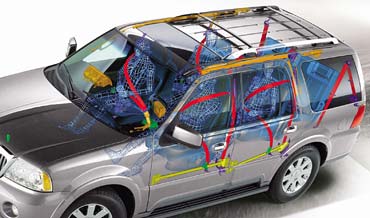
Safety Technology
Automakers are committed to enhancing global road safety through their products and through initiatives such as the Global Road Safety Partnership (GRSP) or the World Health Organisation Road Safety Collaboration. Great achievements have already been obtained and the vehicle industry is continuing to play its role in improving road safety.
Safety Belts
Automakers are providing safety belts worldwide.
For all the safety technology available, safety belts are the most effective safety tools ever implemented. Making them universally standard is critical now in order to prevent potential increases in traffic fatalities, as developing countries increase auto use 18 percent annually. In 2006, 17 automakers joined together to commit to advancing safety belts worldwide.
Safety belts must be buckled to save lives.
The most significant and immediate opportunities to reduce injuries are through changes to driver behavior – especially buckling safety belts. Automakers have committed to various initiatives to support safety belt use, including working with governments to encourage the adoption of and effective enforcement of laws requiring safety belt usage.
Road safety is a shared responsibility.
Automakers are strongly committed to being part of the solution, and other stakeholders have an extremely important share in road safety. Road safety is built on three pillars: the vehicle, the road user and the infrastructure. Overall, about 95 percent of road accidents can be attributed to driver behavior. Traffic rules must be established and obeyed by the general public, following education and enforcement campaigns. Road construction and maintenance must follow the best international practice. Only through a combination of efforts by all parties involved can road safety be further improved and mobility remain sustainable.
Global Efforts
Globally harmonized safety standards benefit all countries.
Road safety worldwide will be best served if viewed from a global perspective. International harmonization will help ensure that vehicles meet the same basic specifications worldwide and are equipped with the necessary features. As the accredited representative of the worldwide vehicle industry, OICA is now working with governments and the UN to develop global technical regulations on a wide range of safety issues, notably pedestrian protection.
New Technologies
Automakers are continually making safety technology advancements.
Automobile manufacturers have developed today’s automobiles with greatly improved safety systems and many important safety features, making new vehicles safer than ever. Vehicle braking, stability and lighting have been improved far beyond the levels required by legislation, by a mixture of technical evolution and advanced technology, making cars more able to avoid accidents. Accident survivability has also been improved well ahead of legislation by designing cars to deform in a controlled way in frontal, side and rear impacts and by the addition of advanced restraint and airbag systems. Tomorrow’s safety technologies are in research and development and in some cases even on the production line today.
